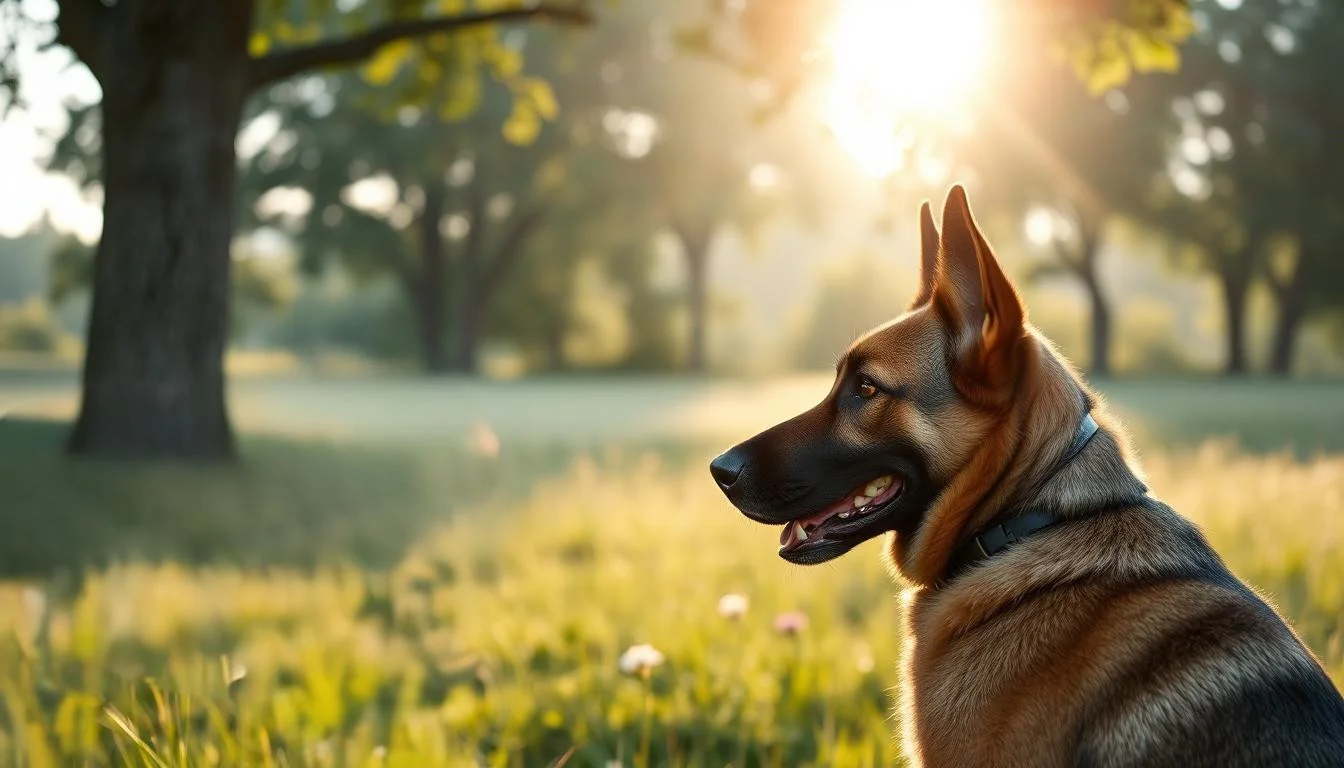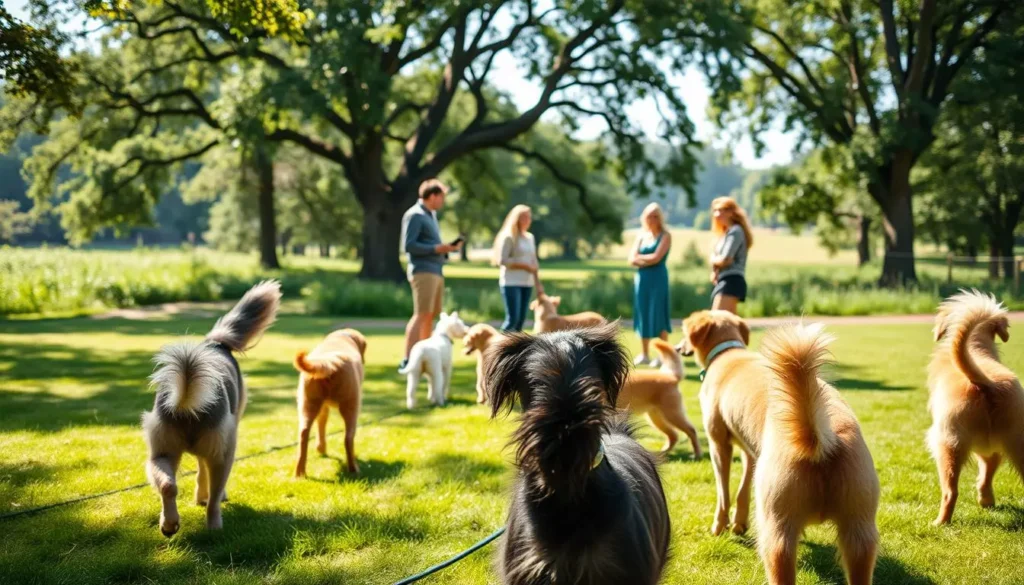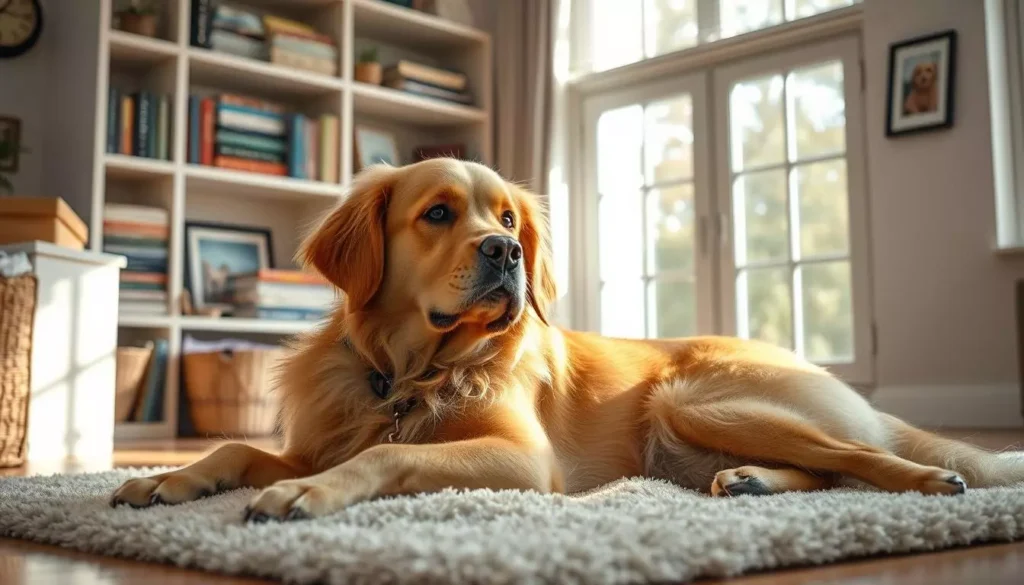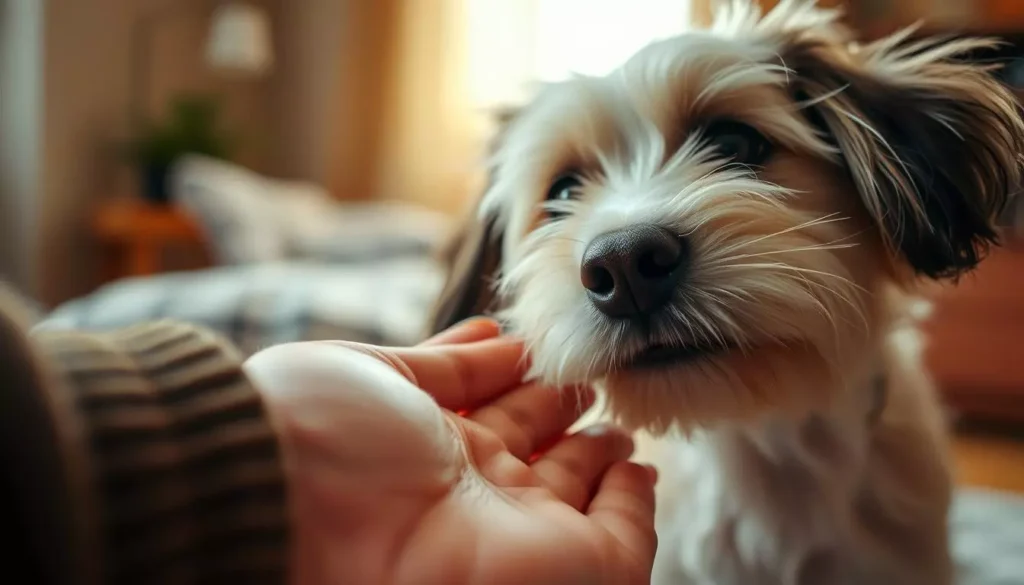I remember my first time in a local park watching a German Shepherd. It was calm and focused, showing the difference between play and purpose. I wanted my dog to be safe, confident, and reliable, not reactive or dangerous. This moment shaped my approach to basic protection dog training.
In this guide, I'll set clear expectations. It offers practical, safe, and ethical tips for owners in the United States. We'll cover drives, defensive responses, and how to assess if your dog is suited for protection work.
We'll also discuss core obedience, proper socialization, and using prey drive constructively. This is an entry point for handlers seeking beginner guard dog training. It's not a substitute for in-person professional instruction or certified courses.
I write for owners considering personal protection canine training. My aim is to give you clear, humane steps. Your dog will become a secure, reliable partner, not a liability.
Key Takeaways
- basic protection dog training should prioritize safety, ethics, and clear boundaries.
- Foundational protection dog training begins with assessing drives and temperament.
- Introductory protection dog classes and beginner guard dog training are complements, not replacements, for hands-on professional coaching.
- Core obedience and thoughtful socialization reduce false positives and create a reliable partner.
- Health, conditioning, and gradual introduction to defensive pressure are essential to long-term success.
Understanding the drives behind protection work
I start by understanding the instincts of a protection dog. I look at prey drive, defensive drive, fight drive, and avoidance. These drives show in how the dog stands, barks, wags its tail, and grips. I watch for these signs before adding more pressure.
Prey work is the first step in training a protection dog. It shows early and is fun. A wagging tail and a bright bark mean the dog wants to chase and grab. I teach bite mechanics with toys and sleeves, keeping the dog safe.
I wait until puberty to introduce serious pressures. Defensive drive comes later and feels different. The bark is deeper, and the dog may lower its tail. Defensive bites often come from the front of the mouth. I don't force this drive in young dogs.
Fight drive is a mix of prey and defense plus real experience. Dogs with strong fight drive see the helper as a partner in conflict. This trait grows with careful exposure and handling.
Avoidance is different from hesitation and needs special handling. Avoidance means the dog retreats or runs away. I protect the dog's confidence and reduce avoidant responses with positive steps. Hesitation is a sign of learning and deserves patience, not punishment.
Genetics play a big role. Some breeds, like Labrador Retrievers and Golden Retrievers, may excel in obedience but lack defensive or fight drive. Fundamental protection k9 training starts with honest assessment. If a dog lacks the right drives, I focus on skills that match its temperament.
When training, I watch for fatigue. Prey drive drops with tiredness, but defensive drive stays steady. I keep sessions short and read signals to avoid pushing an immature dog too hard. Professional guidance helps time the shift from prey-based drills to controlled defensive exercises.
Assessing if your dog is suited for protection training
I start by looking at three key traits: prey interest, defensive potential, and forwardness. These traits tell me more than breed labels alone. Genetics and temperament are important, but early behavior often predicts future ability.
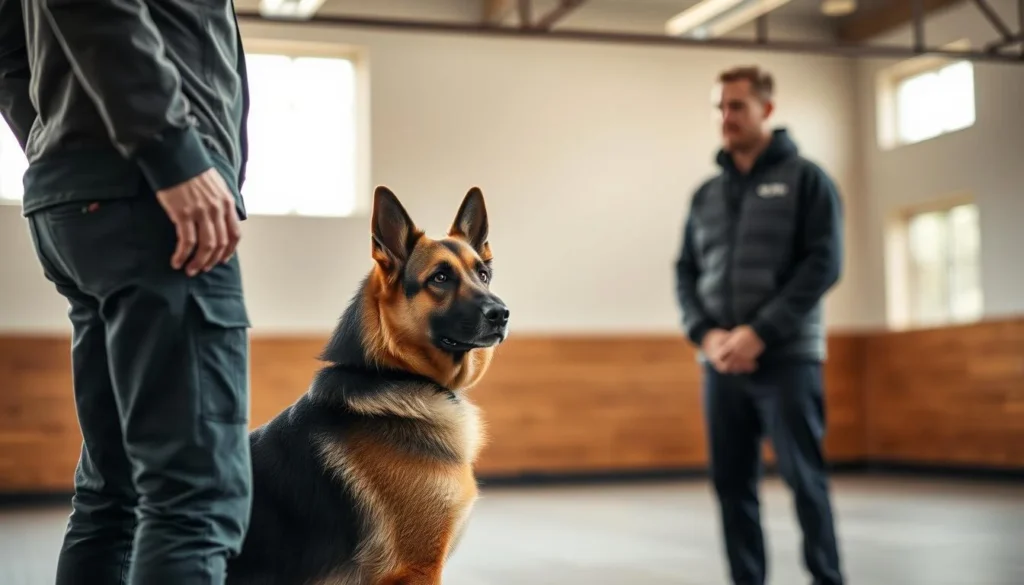
I recommend a clear, staged approach before serious work. A protection dog training online course can teach basics, but hands-on observation is key. I watch puppies at play for sustained chase and object focus. This early prey drive shows as early as six weeks and gives a valuable signal.
Genetics and temperament: what breeds and bloodlines typically excel
I consider breed tendencies and individual bloodlines. German Shepherds, Belgian Malinois, Dutch Shepherds, Rottweilers, and Giant Schnauzers often appear on lists. I still check the bloodline for proven defensive traits, since some German Shepherd lines lack the needed defensive drive.
I pay attention to genetics and temperament together. A good bloodline will show consistent defensive responses by puberty. Defensive drive often surfaces between 11 and 14 months and matures through the second or third year in some lines.
Behavioral signs to look for at puppy and adolescent stages
I track specific signs in young dogs. Sustained interest in chasing, confident approaches to new people, eagerness to work, and solid impulse control are positive markers. I test for reliable recall under mild distraction to see how the dog balances focus and excitement.
Warning signs matter. Frequent tail-tucking, avoidance with mild stress, or unfocused, overexcited play tell me a dog may not be a candidate for personal protection. Those dogs might excel as family companions or in sports that channel prey drive differently.
Why some dogs (including many labs and goldens) may lack defensive drive
I explain candidly to owners that not every dog can or should be a protector. Labradors and golden retrievers often show high retrieving and prey drive. They can alert or bark, but many will avoid direct confrontation and retreat rather than engage.
A resource guarding dog or a resource guarding golden retriever may display intense attachment to objects, yet that behavior does not equal defensive engagement toward threats. I advise owners that training for alerting or territorial cues can be productive for these breeds, while full personal protection training may not be realistic.
| Assessment Area | Positive Indicator | Red Flag |
|---|---|---|
| Prey interest | Long, focused chase/play and object possession | Short, unfocused bursts or no sustained interest |
| Defensive potential | Confident approach to strangers, threshold responses at puberty | Avoidance, tail tucking, excessive fear |
| Trainability | Responsive to correction, strong recall under distraction | Poor focus, inconsistent response to basic commands |
| Breed tendencies | Working breeds with proven lines (measured per bloodline) | Companion breeds with high retrieve but low defense |
| Household fit | Owner commitment to training, safe environment for children | Lack of time, liability concerns, mixed expectations |
Essential foundational obedience before protection work
I start with building a strong obedience base before moving to defensive training. This ensures training is safe and clear. It also makes it easier to add protection skills later without confusion.
I focus on core commands and gradually add distractions. I use rewards for recall, leash work, and controlling impulses. These steps are key for both obedience and guard dog training.
Core commands every protection dog must have rock solid
Every dog needs to master sit, down, stay, heel, and recall quickly. I also teach quiet and leave it commands. These are the basics of guard dog obedience.
I train in short, frequent sessions. I only increase distance and distractions after the dog is consistent.
Building reliable recall and leash control under distraction
I use long-line work to add distance safely. I start recalls at two to three feet, then move to yards and crowds. I reward fast, correct returns with treats or play.
Leash control is about a loose leash, prompt attention, and calm walking. I practice in stressful situations to teach obedience under pressure.
Role of consistent reinforcement and handler communication
I use clear cues and consistent gestures. I mark correct responses with a clicker or verbal marker, then reward. This method speeds up learning and reduces mistakes.
I remain calm and assertive. Mixed signals can cause training breakdowns. Consistent reinforcement helps the dog trust commands in tense moments.
| Skill | Training Focus | Practice Tip |
|---|---|---|
| Recall | Fast, reliable return under distraction | Long-line work, high-value rewards, progressive exposure |
| Heel | Loose-leash walking and attention at side | Short sessions, intermittent rewards, real-world walks |
| Stay/Place | Controlled waits with delayed release | Increase duration and distance slowly, add distractions |
| Leave It / Quiet | Impulse control around temptations and noise | Reward ignoring distractions, practice with toys and food |
| Handler Communication | Consistent cues, timing, and calm leadership | One-word commands, matched gestures, immediate marking |
By combining these elements, training becomes structured and safe. I never rush into defense without experienced help. Solid obedience provides an off switch and makes progression predictable and controlled.
Socialization and environment preparation for protection dogs
I train protection dogs with the same care as any working canine. Early socialization teaches them to spot danger and ignore everyday people and sounds. This helps prevent mistakes in public or at home.
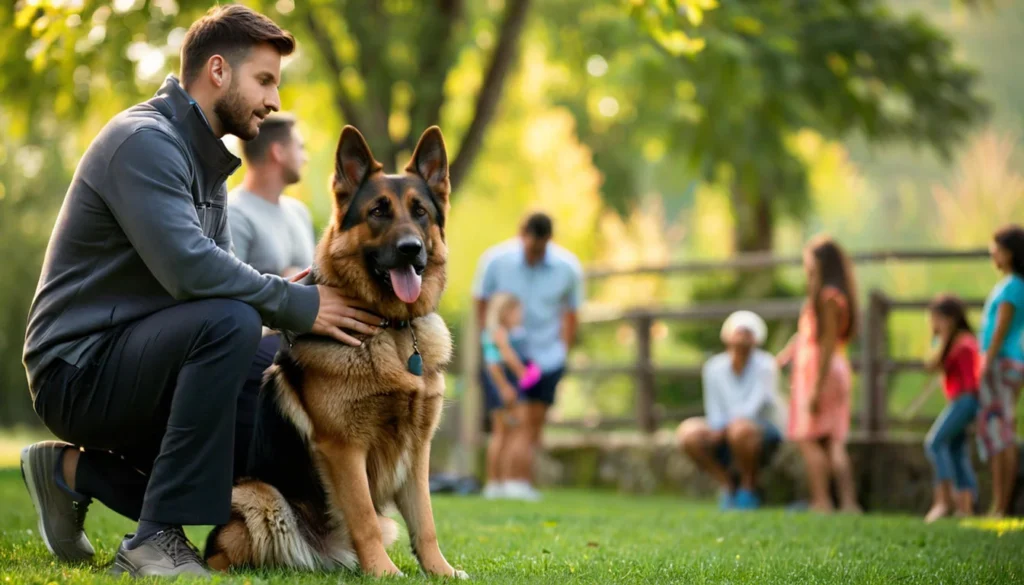
I start with short, positive exposures. Puppies meet men and women of different ages, children, and people in uniforms. I add dogs, scooters, and busy sidewalks. Each session is calm and reward-driven, teaching them that new things can be safe.
Why confident socialization reduces false positive aggression
I teach clear signals for alert and for calm. Dogs learn an “alert/speak” cue and a “quiet/hush” cue. This reduces misdirected bites and unwanted lunges during training.
Exposing your dog to noises, people, and public places safely
I use graded noise work and controlled outings to desensitize dogs. They learn to ignore sirens, construction, and crowded stores. Each exposure grows tolerance while I reinforce focus on me. Personal protection canine training demands ignoring distractions until given a task.
Establishing guarded territory vs. acceptable public behavior
I set clear boundaries at home. The dog understands where guarding is allowed and where it is not. On walks, I reward calm inspection of thresholds and teach the dog to return to heel after a perimeter check. This routine prevents escalation when strangers enter the property.
Managing resource guarding tendencies
If I spot a resource guarding dog, I follow structured exchanges and reward-based handling. This reduces possessiveness. With breeds prone to guarding items, I use small, frequent trades and “leave it” drills to build trust.
Practical steps I use in training
- Start exposures in puppyhood, short and frequent.
- Use supervised interactions with varied ages and appearances.
- Train in parks, streets, and permitted stores for real-world context.
- Practice perimeter walks, stranger approaches, and rewarded alerts.
- Teach “leave it,” “alert/speak,” and “quiet/hush” as core cues.
| Focus Area | Early Puppy Work | Adolescent Training | Adult Maintenance |
|---|---|---|---|
| Noise desensitization | Short, positive sound sessions | Controlled city visits with rewards | Regular refreshers during walks |
| Human variety | Meet men, women, children | Introduce uniforms and bearded faces | Train calm behavior around strangers |
| Dog-to-dog skills | Gentle play and graded exposure | Supervised group walks | Ongoing social outings for focus |
| Territory cues | Household routines and boundaries | Perimeter checks and approach drills | Clear guard vs. public behavior rules |
| Resource control | Exchange games and “leave it” | Structured feeding and toy protocols | Preventive handling to limit guarding |
While I teach personal protection canine training, I keep social exposure humane and gradual. This balance lets me shape confident protectors who can perform tasks without misreading harmless situations.
Using prey drive constructively in training
I use prey drive training to connect play with serious protection work. Short, focused sessions help me turn enthusiasm into reliable actions. I make sure the dog knows when we're training and when it's time to stop.
Teaching bite mechanics with toys, sacks, and sleeves
I start with toys and tug to teach grip and follow-through. Then, I introduce a bite sack, followed by tubes and sleeves as the dog gets better. I reward them for holding tight.
When we move to sleeves, I make sure they focus on the sleeve, not my arms. This helps them learn to target objects correctly.
How prey work serves as a comfort zone to relieve stress
Most dogs find prey play calming. I use it to help them relax after defensive training. A few minutes of tug can lower stress and keep them focused.
Mixing prey tasks into basic training makes it fun and predictable. This keeps the dog engaged without confusing them.
Managing fatigue so prey drive remains effective, not diminished
Fatigue can reduce drive. I keep sessions short and watch for signs of tiredness. If they slow down or lose interest, I stop before they get too tired.
Alternating prey work with obedience helps control impulses. This keeps the dog's energy up for protection training later.
I use safe, well-fitted sleeves and beginner gear at every stage. Keeping games structured and fun helps avoid aggression. This way, prey drive remains a valuable training tool while teaching important skills.
Introducing defensive skills and controlled threats
I start by teaching patience. I wait until a dog is mentally ready and has a strong prey instinct. This is usually around 11–14 months. But full defensive training often starts later, between 18–36 months, to avoid fear.
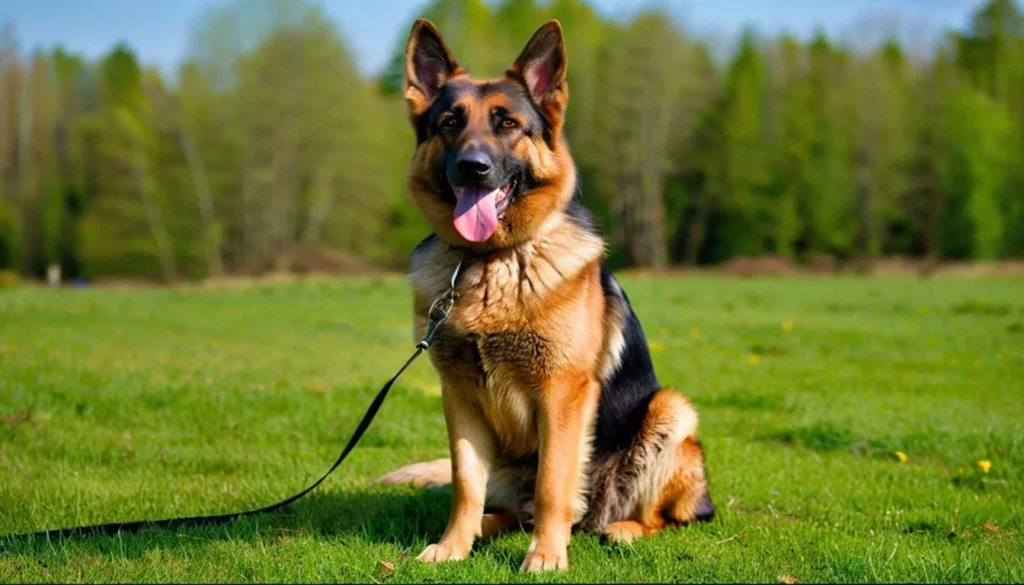
For those needing guidance, I recommend a protection dog training online course. It helps complement hands-on training with a skilled helper. I use staged scenarios to teach dogs about context and clear cues, keeping their trust.
It's crucial to have a skilled helper to adjust the intensity. They must understand the dog's limits and apply pressure carefully. Without experience, helpers might cause fear or long-term damage.
Controlled threat exercises are done in a step-by-step manner. We start with approach and assertive posture, then block access. We use padded gear for physical pressure, focusing on recall and release. Sessions are short and end calmly.
Teaching handlers to recognize defensive signals is key. A defensive bark is deeper and more guttural. The dog's hair may stand up, teeth show, and tail lower than in play. Defensive grip is different from prey work.
We practice real-world scenarios in safe settings. We simulate doorbell disturbances, controlled breaches, and sudden approaches. This helps dogs learn to distinguish training from everyday life, keeping everyone safe.
| Focus | Age Range | Key Trainer Role | Core Drill |
|---|---|---|---|
| Preliminary exposure | 11–14 months (limited) | Monitor thresholds | Short approach, reward calm |
| Progressive defense | 18–36 months | Skilled helper calibrates pressure | Blocked access to padded contact |
| Signal recognition | All ages during training | Handler reads body language | Practice release on cue, observe bark/grip |
| Context drills | After socialization baseline | Instructor-led scenarios | Doorbell, perimeter, sudden approach |
| Supplemental learning | Any time during program | Online coursework support | Protection dog training online course modules |
Personal protection techniques and aggression control
I focus on steps that keep handlers and dogs safe. In personal protection canine training, I teach clear cues and boundaries. This helps the dog know when to act and when to stop.
I start with consistent command work in quiet spaces. Then, I add distractions and real-world scenarios. Teaching verbal command response means repeating a single word or gesture until the dog responds instantly in any setting.
I use short drills to teach impulse control. These include leave-it practice, sit-stays, and timed waits. Each success gets immediate praise, showing the dog that restraint is rewarding.
Realistic scenarios combine obedience with pressure. I increase complexity slowly and require the dog to follow commands under stress. This method reduces false positives and builds confidence.
Not every dog will develop a high level of intensity. A careful transition to fight drive is only for mature, well-selected dogs. I expose them to controlled confrontations where they can win small victories. This helps them combine forward prey interest with defensive resolve.
Handlers should not try advanced steps alone. I recommend working with experienced trainers for any deep fight-drive work. Basic protection dog training and professional oversight keep development safe and ethical.
Bite work, safety, and ethical considerations
I've learned a lot about basic protection dog training. I've talked to certified trainers and handlers too. Bite work can teach useful skills, but it also raises important safety, legal, and ethical questions.
The right gear is key for safety and learning. I suggest using certified sleeves and suits for a controlled learning process. These should fit well and be checked often to avoid injuries.
Helpers play a big role in safe training sessions. They need to meet strict standards. This includes having experience, responding well to commands, and staying calm and consistent.
Before starting, think about the legal risks of having a bite-trained dog. Check local laws, insurance policies, and potential lawsuits. If you have kids or guests often, you'll need to keep your dog safe and controlled.
Ethics are important in training. The goal should be to teach controlled protection, not just aggression. Training that's too aggressive can be dangerous and break trust.
Advanced attack work is very risky. I only let professionals or certified trainers do it. This keeps everyone safe and respects community standards.
Before starting bite work, ask yourself why you want a trainer. Classes and certified trainers can help with temperament checks, safe techniques, and choosing the right gear. They also help with insurance and legal issues.
I've made a table to help you understand the differences between home practice and professional training. It shows the importance of safety, legal issues, and behavior outcomes.
| Aspect | Home Practice | Supervised/Professional |
|---|---|---|
| Equipment | Intro toys, worn bite pillows, basic sleeves | Certified sleeves and suits, munition tubes, maintained gear |
| Safety Procedures | Informal, variable; greater chance of lapses | Standardized protocols, emergency plans, helper standards enforced |
| Legal Exposure | Higher uncertainty about insurance and local laws | Pre-assessment of legal liability bite-trained dogs and documentation |
| Behavioral Outcome | Risk of unintended aggression without release control | Controlled protection, clear release, ethical boundaries |
| Who Should Lead | Experienced owners with strict boundaries | Certified protection dog trainers; police or military experience preferred |
Health, fitness, and common training challenges
I focus on keeping working dogs healthy and sharp. Daily routines mix steady runs, sprint intervals, tug, and play. This builds their conditioning without losing their prey instinct. I also use short mental drills to keep their focus high and boredom low.
Conditioning, agility, and nutrition for working dogs
I believe in gradual progress for k9 fitness. Start with low-impact cardio, then add sprint intervals and hill work for power. Agility and nutrition plans improve coordination and support joints.
I recommend balanced diets from reputable brands like Royal Canin or Purina Pro Plan. Plus, vet-approved joint supplements such as glucosamine and omega-3s for recovery. I keep sessions short on high-intensity days to protect their drive and endurance.
Preventing and managing training injuries
Injury prevention is simple when done consistently. Warm-ups should include light trot and mobility drills. Cooldowns with walking and gentle stretching reduce stiffness.
I watch surfaces and equipment closely to avoid slips. For preventing training injuries, I scale intensity, use non-slip flooring, and rest when a dog shows limping or stiffness. If pain persists, I contact my veterinarian for diagnosis and rehab options.
Addressing fear-based reactions, inconsistent obedience, and handler errors
Fear-based shutdowns or tail tucks demand a careful, patient plan. I back off pressure, shorten sessions, and reward small wins. Socialization helps reduce false positives later on.
Inconsistent obedience often traces back to unclear cues or long sessions. I tighten criteria, reward clarity, and keep drills brief. When training challenges escalate, I seek a certified protection trainer or behaviorist for targeted help.
| Area | Daily Practice | Warning Signs | When to Seek Professional Help |
|---|---|---|---|
| Cardio & Conditioning | Steady runs, sprint intervals, tug play | Excess fatigue, loss of prey drive, heavy panting | Persistent drop in performance or reluctance to exercise |
| Agility & Coordination | Short agility courses, weave drills, balance work | Stiffness after sessions, slipping, decreased coordination | Recurring joint issues or acute injury during drills |
| Nutrition & Recovery | Balanced diet, joint supplements, scheduled rest | Poor coat, slow recovery, weight loss or gain | Ongoing digestive problems or failure to recover |
| Behavior & Obedience | Short focused sessions, clear cues, social exposure | Inconsistent responses, fear-based reactions, uncontrolled aggression | Unmanageable lunging, aggression, or trauma signs |
| Injury Prevention | Warm-up, cool-down, proper surfaces, progressive intensity | Limping, swelling, reluctance to move | Any recurring pain or mobility loss |
Conclusion
Basic protection dog training starts with a clear assessment and solid obedience. Essential guard dog obedience and recall are key. Without them, training becomes dangerous for both the dog and handler.
Prey drive can be used safely in training. Defensive and fight drives are mostly genetic. They should only be introduced when the dog is mature.
Socialization helps avoid false positives. Bite work needs proper sleeves, suits, and trained helpers. It also requires legal awareness to keep everyone safe.
To move forward, check your dog's temperament and tighten obedience. Consider introductory protection dog classes or online courses. If unsure, talk to a certified protection trainer in the U.S. before starting defensive or bite work.
My goal is to train responsibly, protecting the dog, handler, and public. Always follow safe progress and prioritize ethics in personal protection canine training or guard dog obedience.

